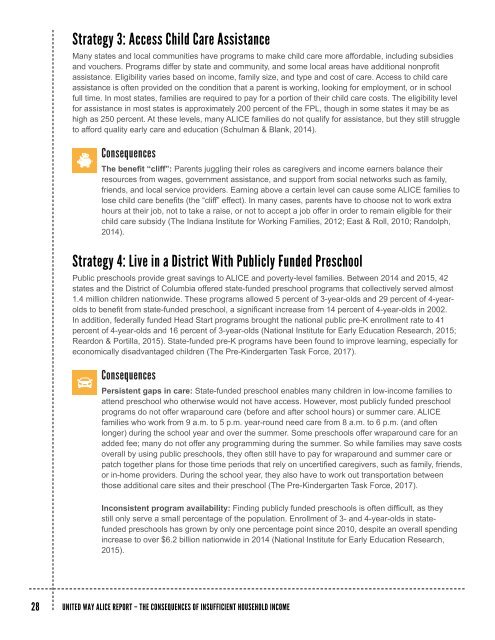The Consequences of Insufficient Household Income
This new Consequences of Insufficient Household Income report provides a deeper level of understanding of the choices that ALICE and poverty-level families across the country make when they do not have enough income or assistance to afford basic necessities, and the consequences of those choices.
This new Consequences of Insufficient Household Income report provides a deeper level of understanding of the choices that ALICE and poverty-level families across the country make when they do not have enough income or assistance to afford basic necessities, and the consequences of those choices.
You also want an ePaper? Increase the reach of your titles
YUMPU automatically turns print PDFs into web optimized ePapers that Google loves.
Strategy 3: Access Child Care Assistance<br />
Many states and local communities have programs to make child care more affordable, including subsidies<br />
and vouchers. Programs differ by state and community, and some local areas have additional nonpr<strong>of</strong>it<br />
assistance. Eligibility varies based on income, family size, and type and cost <strong>of</strong> care. Access to child care<br />
assistance is <strong>of</strong>ten provided on the condition that a parent is working, looking for employment, or in school<br />
full time. In most states, families are required to pay for a portion <strong>of</strong> their child care costs. <strong>The</strong> eligibility level<br />
for assistance in most states is approximately 200 percent <strong>of</strong> the FPL, though in some states it may be as<br />
high as 250 percent. At these levels, many ALICE families do not qualify for assistance, but they still struggle<br />
to afford quality early care and education (Schulman & Blank, 2014).<br />
<strong>Consequences</strong><br />
<strong>The</strong> benefit “cliff”: Parents juggling their roles as caregivers and income earners balance their<br />
resources from wages, government assistance, and support from social networks such as family,<br />
friends, and local service providers. Earning above a certain level can cause some ALICE families to<br />
lose child care benefits (the “cliff” effect). In many cases, parents have to choose not to work extra<br />
hours at their job, not to take a raise, or not to accept a job <strong>of</strong>fer in order to remain eligible for their<br />
child care subsidy (<strong>The</strong> Indiana Institute for Working Families, 2012; East & Roll, 2010; Randolph,<br />
2014).<br />
Strategy 4: Live in a District With Publicly Funded Preschool<br />
Public preschools provide great savings to ALICE and poverty-level families. Between 2014 and 2015, 42<br />
states and the District <strong>of</strong> Columbia <strong>of</strong>fered state-funded preschool programs that collectively served almost<br />
1.4 million children nationwide. <strong>The</strong>se programs allowed 5 percent <strong>of</strong> 3-year-olds and 29 percent <strong>of</strong> 4-yearolds<br />
to benefit from state-funded preschool, a significant increase from 14 percent <strong>of</strong> 4-year-olds in 2002.<br />
In addition, federally funded Head Start programs brought the national public pre-K enrollment rate to 41<br />
percent <strong>of</strong> 4-year-olds and 16 percent <strong>of</strong> 3-year-olds (National Institute for Early Education Research, 2015;<br />
Reardon & Portilla, 2015). State-funded pre-K programs have been found to improve learning, especially for<br />
economically disadvantaged children (<strong>The</strong> Pre-Kindergarten Task Force, 2017).<br />
<strong>Consequences</strong><br />
Persistent gaps in care: State-funded preschool enables many children in low-income families to<br />
attend preschool who otherwise would not have access. However, most publicly funded preschool<br />
programs do not <strong>of</strong>fer wraparound care (before and after school hours) or summer care. ALICE<br />
families who work from 9 a.m. to 5 p.m. year-round need care from 8 a.m. to 6 p.m. (and <strong>of</strong>ten<br />
longer) during the school year and over the summer. Some preschools <strong>of</strong>fer wraparound care for an<br />
added fee; many do not <strong>of</strong>fer any programming during the summer. So while families may save costs<br />
overall by using public preschools, they <strong>of</strong>ten still have to pay for wraparound and summer care or<br />
patch together plans for those time periods that rely on uncertified caregivers, such as family, friends,<br />
or in-home providers. During the school year, they also have to work out transportation between<br />
those additional care sites and their preschool (<strong>The</strong> Pre-Kindergarten Task Force, 2017).<br />
Inconsistent program availability: Finding publicly funded preschools is <strong>of</strong>ten difficult, as they<br />
still only serve a small percentage <strong>of</strong> the population. Enrollment <strong>of</strong> 3- and 4-year-olds in statefunded<br />
preschools has grown by only one percentage point since 2010, despite an overall spending<br />
increase to over $6.2 billion nationwide in 2014 (National Institute for Early Education Research,<br />
2015).<br />
28 UNITED WAY ALICE REPORT – THE CONSEQUENCES OF INSUFFICIENT HOUSEHOLD INCOME




